BUS101: Business in Practice - Enterprises, Structures, and Analysis
VerifiedAdded on 2022/11/29
|10
|2555
|137
Report
AI Summary
This report delves into the world of business, exploring diverse enterprise types, ranging from micro to large corporations, and examining the legal structures that govern them, including sole traders, partnerships, limited liability businesses, public limited liability businesses, and cooperatives. It also investigates various organizational structures, such as functional, divisional, and matrix structures, and how they influence business operations. Furthermore, the report applies the PESTEL analysis framework to evaluate the external factors affecting businesses, including political, economic, social, technological, environmental, and legal aspects, using McKinsey & Company as a case study. The report provides a comprehensive overview of business practices and strategic analysis.
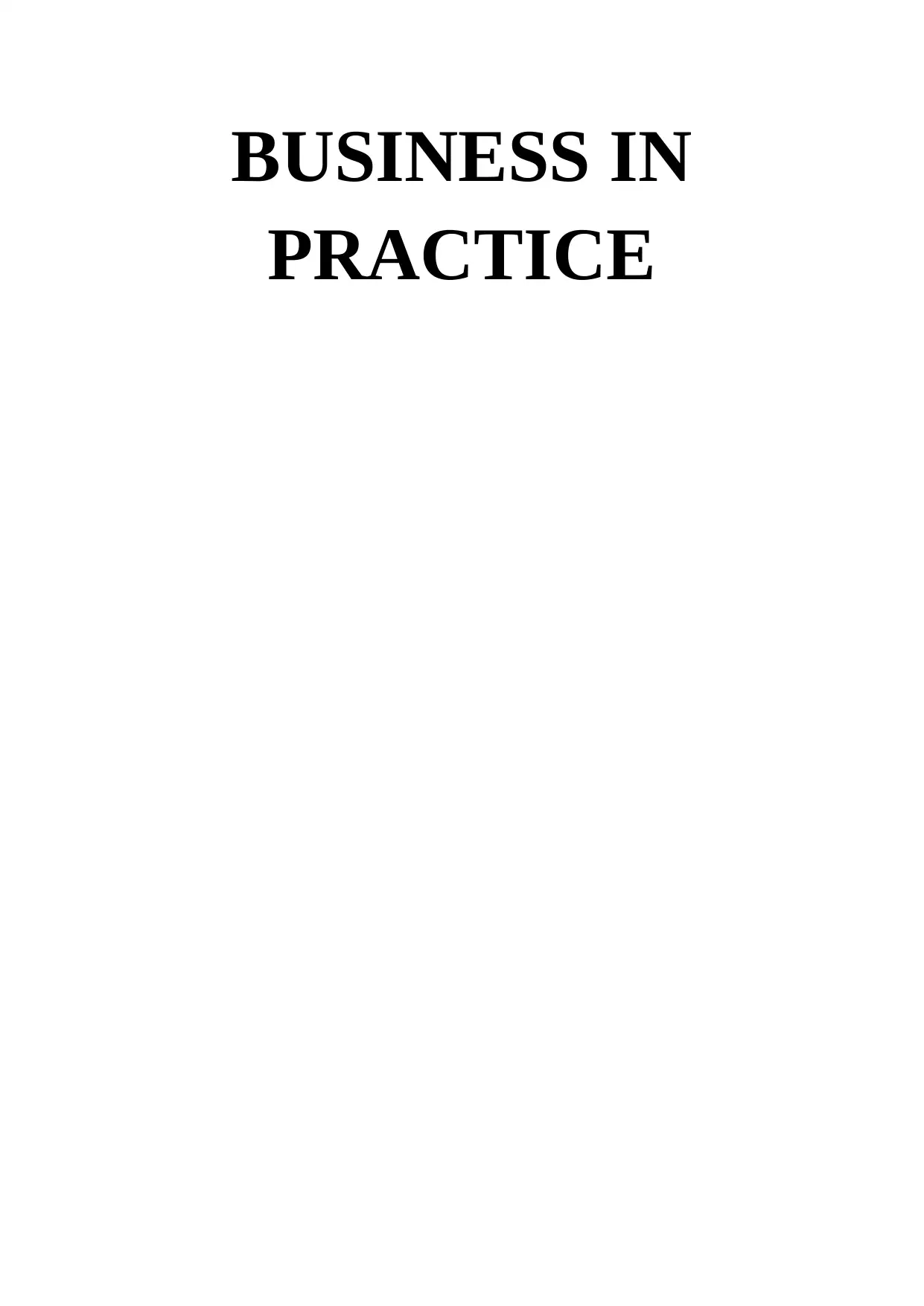
BUSINESS IN
PRACTICE
PRACTICE
Paraphrase This Document
Need a fresh take? Get an instant paraphrase of this document with our AI Paraphraser
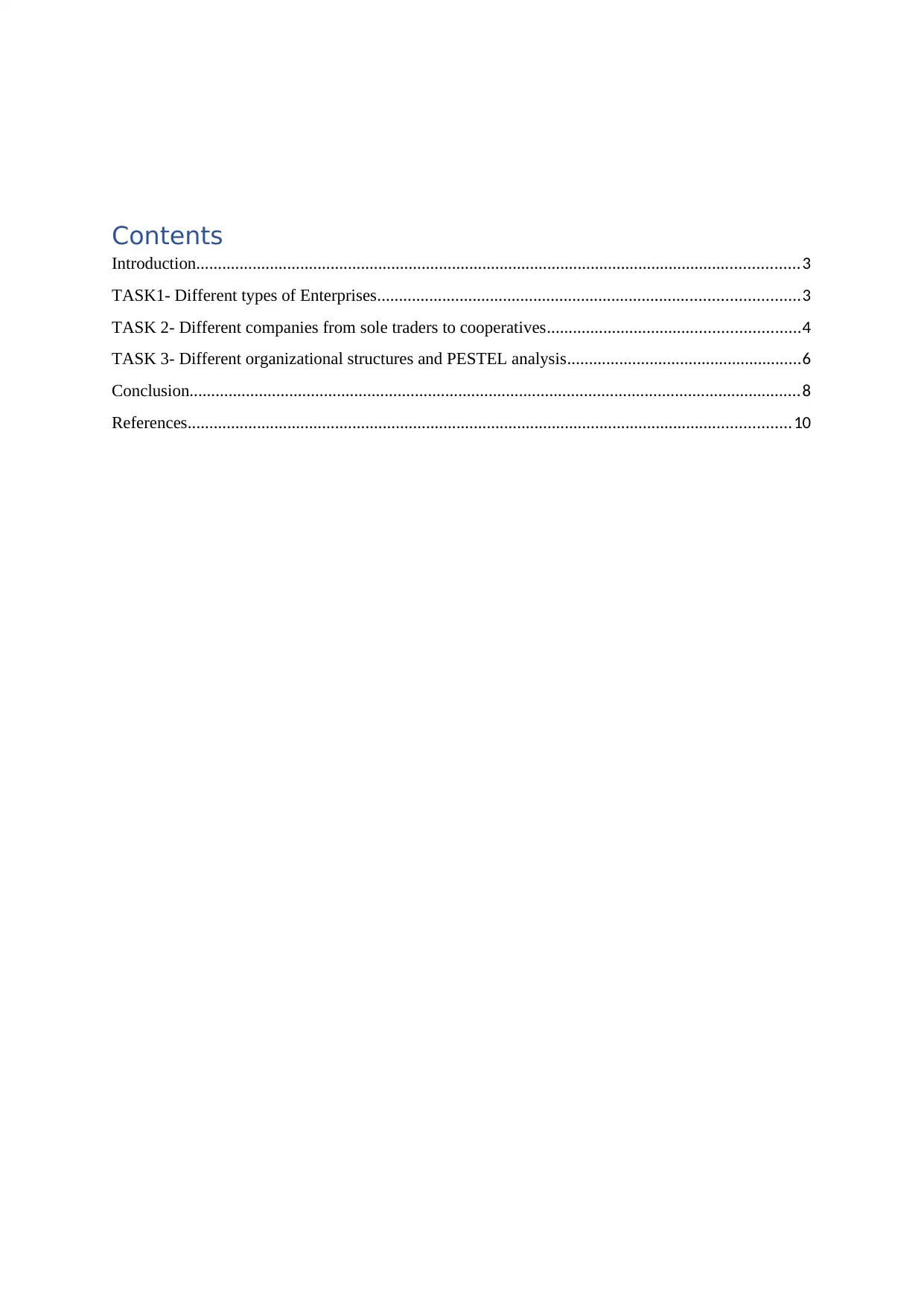
Contents
Introduction...........................................................................................................................................3
TASK1- Different types of Enterprises.................................................................................................3
TASK 2- Different companies from sole traders to cooperatives..........................................................4
TASK 3- Different organizational structures and PESTEL analysis......................................................6
Conclusion.............................................................................................................................................8
References...........................................................................................................................................10
Introduction...........................................................................................................................................3
TASK1- Different types of Enterprises.................................................................................................3
TASK 2- Different companies from sole traders to cooperatives..........................................................4
TASK 3- Different organizational structures and PESTEL analysis......................................................6
Conclusion.............................................................................................................................................8
References...........................................................................................................................................10
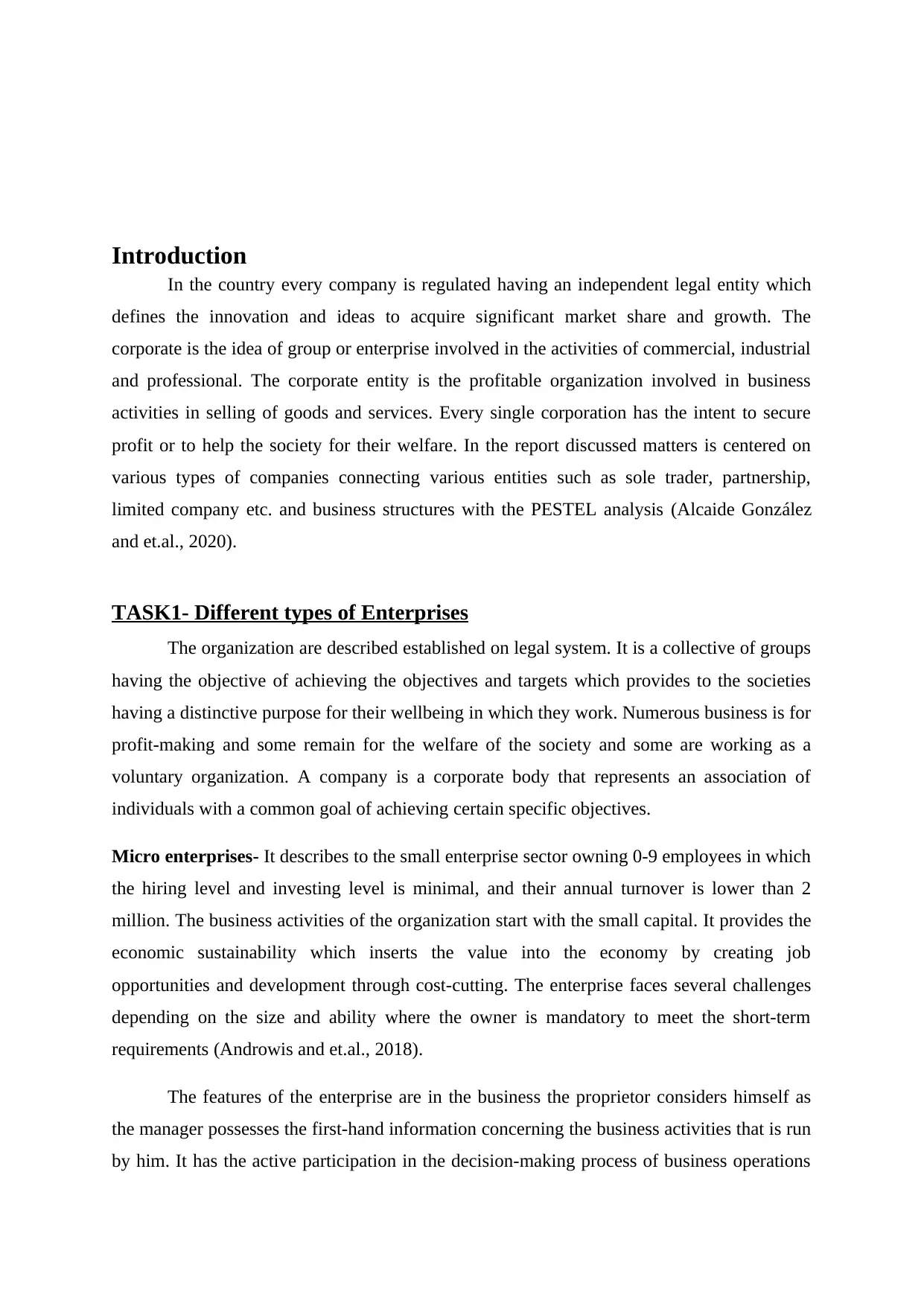
Introduction
In the country every company is regulated having an independent legal entity which
defines the innovation and ideas to acquire significant market share and growth. The
corporate is the idea of group or enterprise involved in the activities of commercial, industrial
and professional. The corporate entity is the profitable organization involved in business
activities in selling of goods and services. Every single corporation has the intent to secure
profit or to help the society for their welfare. In the report discussed matters is centered on
various types of companies connecting various entities such as sole trader, partnership,
limited company etc. and business structures with the PESTEL analysis (Alcaide González
and et.al., 2020).
TASK1- Different types of Enterprises
The organization are described established on legal system. It is a collective of groups
having the objective of achieving the objectives and targets which provides to the societies
having a distinctive purpose for their wellbeing in which they work. Numerous business is for
profit-making and some remain for the welfare of the society and some are working as a
voluntary organization. A company is a corporate body that represents an association of
individuals with a common goal of achieving certain specific objectives.
Micro enterprises- It describes to the small enterprise sector owning 0-9 employees in which
the hiring level and investing level is minimal, and their annual turnover is lower than 2
million. The business activities of the organization start with the small capital. It provides the
economic sustainability which inserts the value into the economy by creating job
opportunities and development through cost-cutting. The enterprise faces several challenges
depending on the size and ability where the owner is mandatory to meet the short-term
requirements (Androwis and et.al., 2018).
The features of the enterprise are in the business the proprietor considers himself as
the manager possesses the first-hand information concerning the business activities that is run
by him. It has the active participation in the decision-making process of business operations
In the country every company is regulated having an independent legal entity which
defines the innovation and ideas to acquire significant market share and growth. The
corporate is the idea of group or enterprise involved in the activities of commercial, industrial
and professional. The corporate entity is the profitable organization involved in business
activities in selling of goods and services. Every single corporation has the intent to secure
profit or to help the society for their welfare. In the report discussed matters is centered on
various types of companies connecting various entities such as sole trader, partnership,
limited company etc. and business structures with the PESTEL analysis (Alcaide González
and et.al., 2020).
TASK1- Different types of Enterprises
The organization are described established on legal system. It is a collective of groups
having the objective of achieving the objectives and targets which provides to the societies
having a distinctive purpose for their wellbeing in which they work. Numerous business is for
profit-making and some remain for the welfare of the society and some are working as a
voluntary organization. A company is a corporate body that represents an association of
individuals with a common goal of achieving certain specific objectives.
Micro enterprises- It describes to the small enterprise sector owning 0-9 employees in which
the hiring level and investing level is minimal, and their annual turnover is lower than 2
million. The business activities of the organization start with the small capital. It provides the
economic sustainability which inserts the value into the economy by creating job
opportunities and development through cost-cutting. The enterprise faces several challenges
depending on the size and ability where the owner is mandatory to meet the short-term
requirements (Androwis and et.al., 2018).
The features of the enterprise are in the business the proprietor considers himself as
the manager possesses the first-hand information concerning the business activities that is run
by him. It has the active participation in the decision-making process of business operations
⊘ This is a preview!⊘
Do you want full access?
Subscribe today to unlock all pages.

Trusted by 1+ million students worldwide
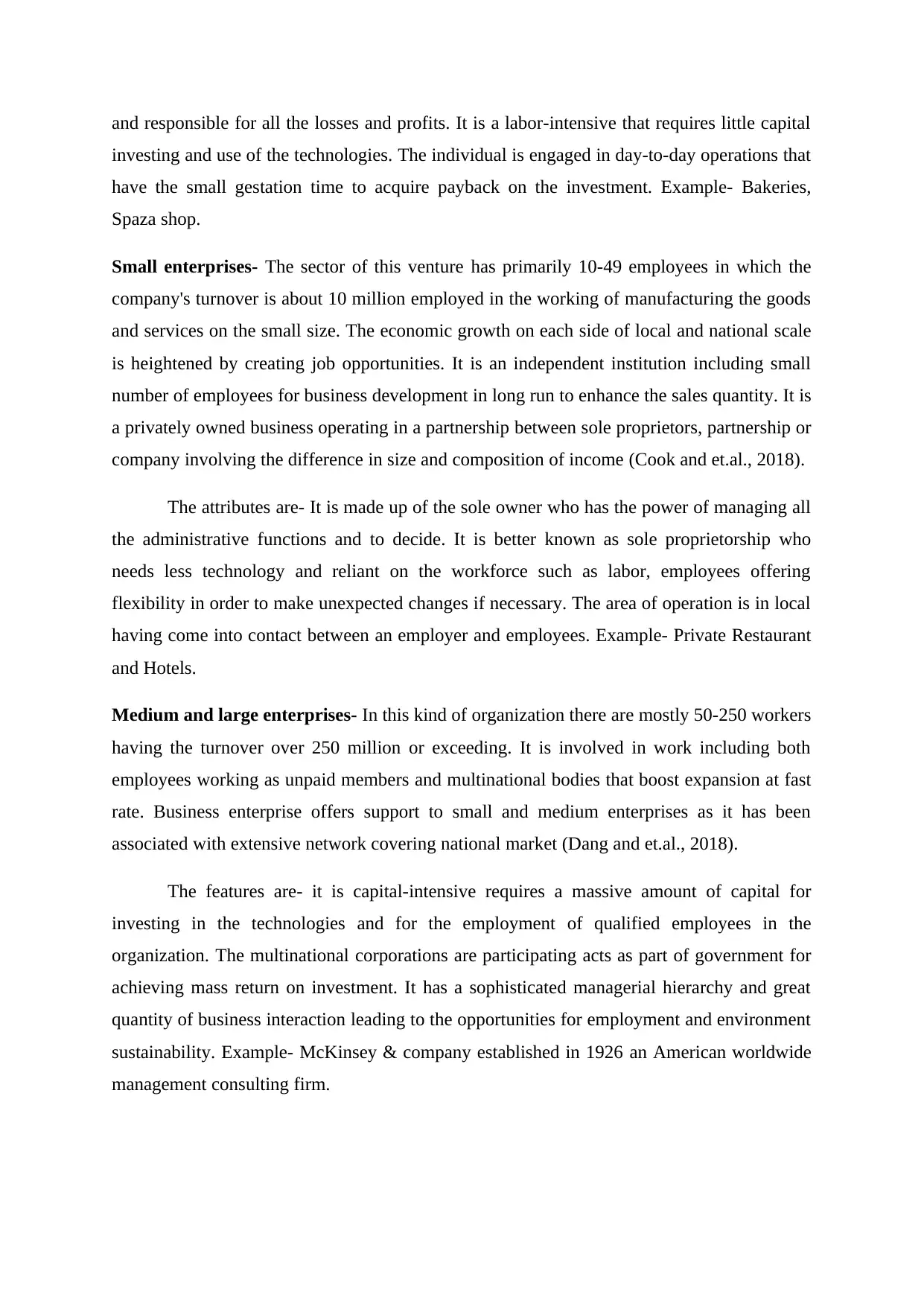
and responsible for all the losses and profits. It is a labor-intensive that requires little capital
investing and use of the technologies. The individual is engaged in day-to-day operations that
have the small gestation time to acquire payback on the investment. Example- Bakeries,
Spaza shop.
Small enterprises- The sector of this venture has primarily 10-49 employees in which the
company's turnover is about 10 million employed in the working of manufacturing the goods
and services on the small size. The economic growth on each side of local and national scale
is heightened by creating job opportunities. It is an independent institution including small
number of employees for business development in long run to enhance the sales quantity. It is
a privately owned business operating in a partnership between sole proprietors, partnership or
company involving the difference in size and composition of income (Cook and et.al., 2018).
The attributes are- It is made up of the sole owner who has the power of managing all
the administrative functions and to decide. It is better known as sole proprietorship who
needs less technology and reliant on the workforce such as labor, employees offering
flexibility in order to make unexpected changes if necessary. The area of operation is in local
having come into contact between an employer and employees. Example- Private Restaurant
and Hotels.
Medium and large enterprises- In this kind of organization there are mostly 50-250 workers
having the turnover over 250 million or exceeding. It is involved in work including both
employees working as unpaid members and multinational bodies that boost expansion at fast
rate. Business enterprise offers support to small and medium enterprises as it has been
associated with extensive network covering national market (Dang and et.al., 2018).
The features are- it is capital-intensive requires a massive amount of capital for
investing in the technologies and for the employment of qualified employees in the
organization. The multinational corporations are participating acts as part of government for
achieving mass return on investment. It has a sophisticated managerial hierarchy and great
quantity of business interaction leading to the opportunities for employment and environment
sustainability. Example- McKinsey & company established in 1926 an American worldwide
management consulting firm.
investing and use of the technologies. The individual is engaged in day-to-day operations that
have the small gestation time to acquire payback on the investment. Example- Bakeries,
Spaza shop.
Small enterprises- The sector of this venture has primarily 10-49 employees in which the
company's turnover is about 10 million employed in the working of manufacturing the goods
and services on the small size. The economic growth on each side of local and national scale
is heightened by creating job opportunities. It is an independent institution including small
number of employees for business development in long run to enhance the sales quantity. It is
a privately owned business operating in a partnership between sole proprietors, partnership or
company involving the difference in size and composition of income (Cook and et.al., 2018).
The attributes are- It is made up of the sole owner who has the power of managing all
the administrative functions and to decide. It is better known as sole proprietorship who
needs less technology and reliant on the workforce such as labor, employees offering
flexibility in order to make unexpected changes if necessary. The area of operation is in local
having come into contact between an employer and employees. Example- Private Restaurant
and Hotels.
Medium and large enterprises- In this kind of organization there are mostly 50-250 workers
having the turnover over 250 million or exceeding. It is involved in work including both
employees working as unpaid members and multinational bodies that boost expansion at fast
rate. Business enterprise offers support to small and medium enterprises as it has been
associated with extensive network covering national market (Dang and et.al., 2018).
The features are- it is capital-intensive requires a massive amount of capital for
investing in the technologies and for the employment of qualified employees in the
organization. The multinational corporations are participating acts as part of government for
achieving mass return on investment. It has a sophisticated managerial hierarchy and great
quantity of business interaction leading to the opportunities for employment and environment
sustainability. Example- McKinsey & company established in 1926 an American worldwide
management consulting firm.
Paraphrase This Document
Need a fresh take? Get an instant paraphrase of this document with our AI Paraphraser
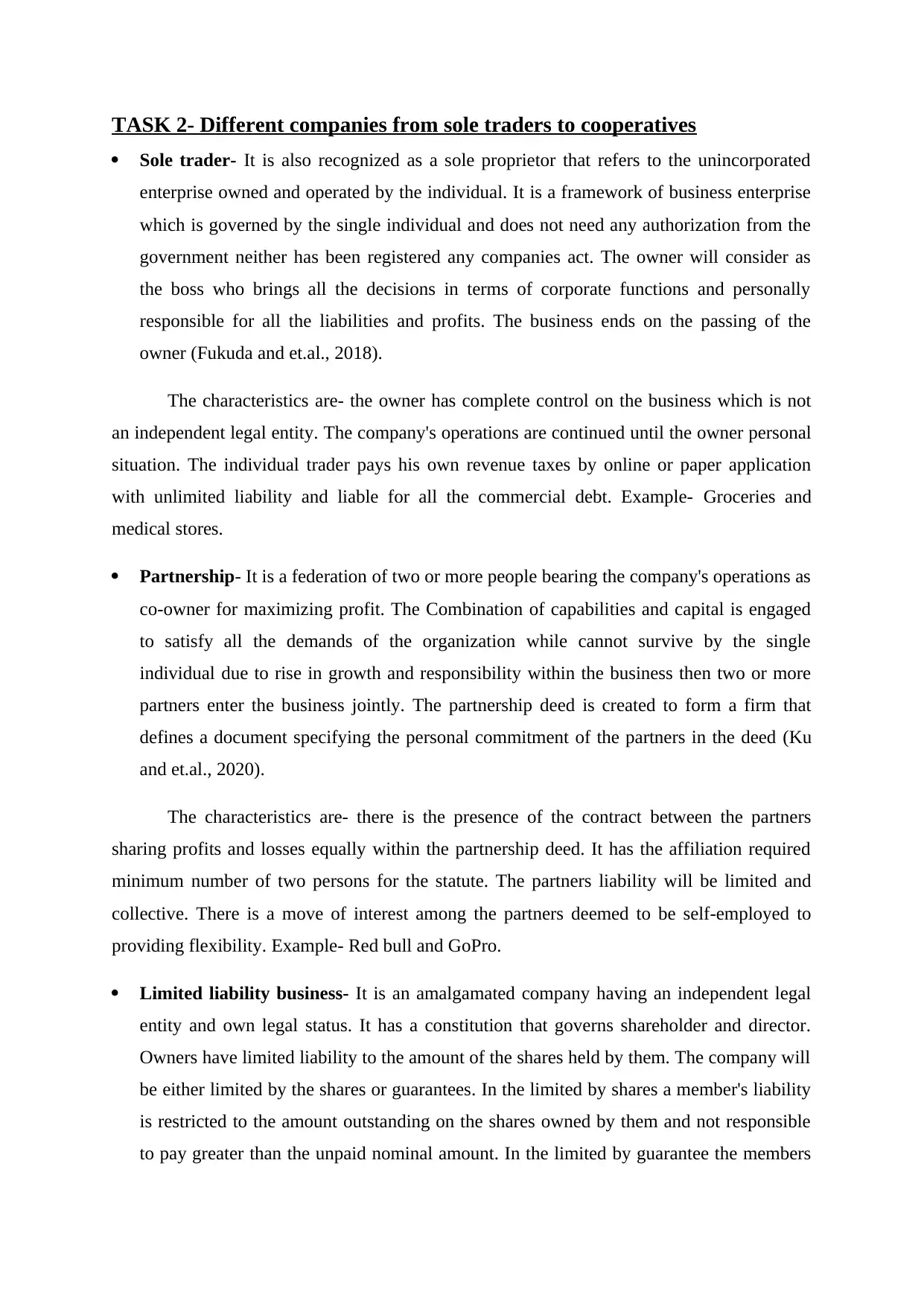
TASK 2- Different companies from sole traders to cooperatives
Sole trader- It is also recognized as a sole proprietor that refers to the unincorporated
enterprise owned and operated by the individual. It is a framework of business enterprise
which is governed by the single individual and does not need any authorization from the
government neither has been registered any companies act. The owner will consider as
the boss who brings all the decisions in terms of corporate functions and personally
responsible for all the liabilities and profits. The business ends on the passing of the
owner (Fukuda and et.al., 2018).
The characteristics are- the owner has complete control on the business which is not
an independent legal entity. The company's operations are continued until the owner personal
situation. The individual trader pays his own revenue taxes by online or paper application
with unlimited liability and liable for all the commercial debt. Example- Groceries and
medical stores.
Partnership- It is a federation of two or more people bearing the company's operations as
co-owner for maximizing profit. The Combination of capabilities and capital is engaged
to satisfy all the demands of the organization while cannot survive by the single
individual due to rise in growth and responsibility within the business then two or more
partners enter the business jointly. The partnership deed is created to form a firm that
defines a document specifying the personal commitment of the partners in the deed (Ku
and et.al., 2020).
The characteristics are- there is the presence of the contract between the partners
sharing profits and losses equally within the partnership deed. It has the affiliation required
minimum number of two persons for the statute. The partners liability will be limited and
collective. There is a move of interest among the partners deemed to be self-employed to
providing flexibility. Example- Red bull and GoPro.
Limited liability business- It is an amalgamated company having an independent legal
entity and own legal status. It has a constitution that governs shareholder and director.
Owners have limited liability to the amount of the shares held by them. The company will
be either limited by the shares or guarantees. In the limited by shares a member's liability
is restricted to the amount outstanding on the shares owned by them and not responsible
to pay greater than the unpaid nominal amount. In the limited by guarantee the members
Sole trader- It is also recognized as a sole proprietor that refers to the unincorporated
enterprise owned and operated by the individual. It is a framework of business enterprise
which is governed by the single individual and does not need any authorization from the
government neither has been registered any companies act. The owner will consider as
the boss who brings all the decisions in terms of corporate functions and personally
responsible for all the liabilities and profits. The business ends on the passing of the
owner (Fukuda and et.al., 2018).
The characteristics are- the owner has complete control on the business which is not
an independent legal entity. The company's operations are continued until the owner personal
situation. The individual trader pays his own revenue taxes by online or paper application
with unlimited liability and liable for all the commercial debt. Example- Groceries and
medical stores.
Partnership- It is a federation of two or more people bearing the company's operations as
co-owner for maximizing profit. The Combination of capabilities and capital is engaged
to satisfy all the demands of the organization while cannot survive by the single
individual due to rise in growth and responsibility within the business then two or more
partners enter the business jointly. The partnership deed is created to form a firm that
defines a document specifying the personal commitment of the partners in the deed (Ku
and et.al., 2020).
The characteristics are- there is the presence of the contract between the partners
sharing profits and losses equally within the partnership deed. It has the affiliation required
minimum number of two persons for the statute. The partners liability will be limited and
collective. There is a move of interest among the partners deemed to be self-employed to
providing flexibility. Example- Red bull and GoPro.
Limited liability business- It is an amalgamated company having an independent legal
entity and own legal status. It has a constitution that governs shareholder and director.
Owners have limited liability to the amount of the shares held by them. The company will
be either limited by the shares or guarantees. In the limited by shares a member's liability
is restricted to the amount outstanding on the shares owned by them and not responsible
to pay greater than the unpaid nominal amount. In the limited by guarantee the members
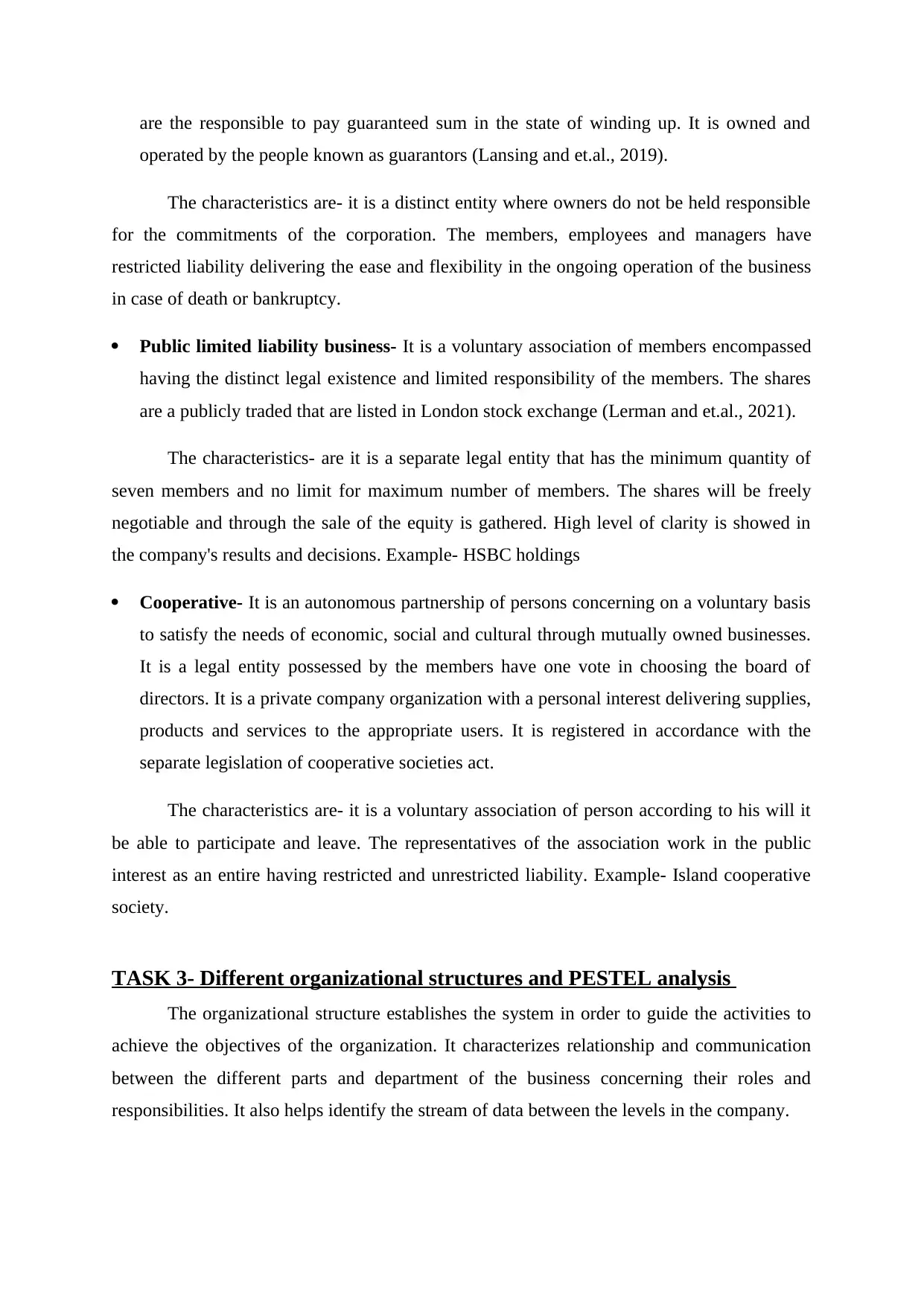
are the responsible to pay guaranteed sum in the state of winding up. It is owned and
operated by the people known as guarantors (Lansing and et.al., 2019).
The characteristics are- it is a distinct entity where owners do not be held responsible
for the commitments of the corporation. The members, employees and managers have
restricted liability delivering the ease and flexibility in the ongoing operation of the business
in case of death or bankruptcy.
Public limited liability business- It is a voluntary association of members encompassed
having the distinct legal existence and limited responsibility of the members. The shares
are a publicly traded that are listed in London stock exchange (Lerman and et.al., 2021).
The characteristics- are it is a separate legal entity that has the minimum quantity of
seven members and no limit for maximum number of members. The shares will be freely
negotiable and through the sale of the equity is gathered. High level of clarity is showed in
the company's results and decisions. Example- HSBC holdings
Cooperative- It is an autonomous partnership of persons concerning on a voluntary basis
to satisfy the needs of economic, social and cultural through mutually owned businesses.
It is a legal entity possessed by the members have one vote in choosing the board of
directors. It is a private company organization with a personal interest delivering supplies,
products and services to the appropriate users. It is registered in accordance with the
separate legislation of cooperative societies act.
The characteristics are- it is a voluntary association of person according to his will it
be able to participate and leave. The representatives of the association work in the public
interest as an entire having restricted and unrestricted liability. Example- Island cooperative
society.
TASK 3- Different organizational structures and PESTEL analysis
The organizational structure establishes the system in order to guide the activities to
achieve the objectives of the organization. It characterizes relationship and communication
between the different parts and department of the business concerning their roles and
responsibilities. It also helps identify the stream of data between the levels in the company.
operated by the people known as guarantors (Lansing and et.al., 2019).
The characteristics are- it is a distinct entity where owners do not be held responsible
for the commitments of the corporation. The members, employees and managers have
restricted liability delivering the ease and flexibility in the ongoing operation of the business
in case of death or bankruptcy.
Public limited liability business- It is a voluntary association of members encompassed
having the distinct legal existence and limited responsibility of the members. The shares
are a publicly traded that are listed in London stock exchange (Lerman and et.al., 2021).
The characteristics- are it is a separate legal entity that has the minimum quantity of
seven members and no limit for maximum number of members. The shares will be freely
negotiable and through the sale of the equity is gathered. High level of clarity is showed in
the company's results and decisions. Example- HSBC holdings
Cooperative- It is an autonomous partnership of persons concerning on a voluntary basis
to satisfy the needs of economic, social and cultural through mutually owned businesses.
It is a legal entity possessed by the members have one vote in choosing the board of
directors. It is a private company organization with a personal interest delivering supplies,
products and services to the appropriate users. It is registered in accordance with the
separate legislation of cooperative societies act.
The characteristics are- it is a voluntary association of person according to his will it
be able to participate and leave. The representatives of the association work in the public
interest as an entire having restricted and unrestricted liability. Example- Island cooperative
society.
TASK 3- Different organizational structures and PESTEL analysis
The organizational structure establishes the system in order to guide the activities to
achieve the objectives of the organization. It characterizes relationship and communication
between the different parts and department of the business concerning their roles and
responsibilities. It also helps identify the stream of data between the levels in the company.
⊘ This is a preview!⊘
Do you want full access?
Subscribe today to unlock all pages.

Trusted by 1+ million students worldwide
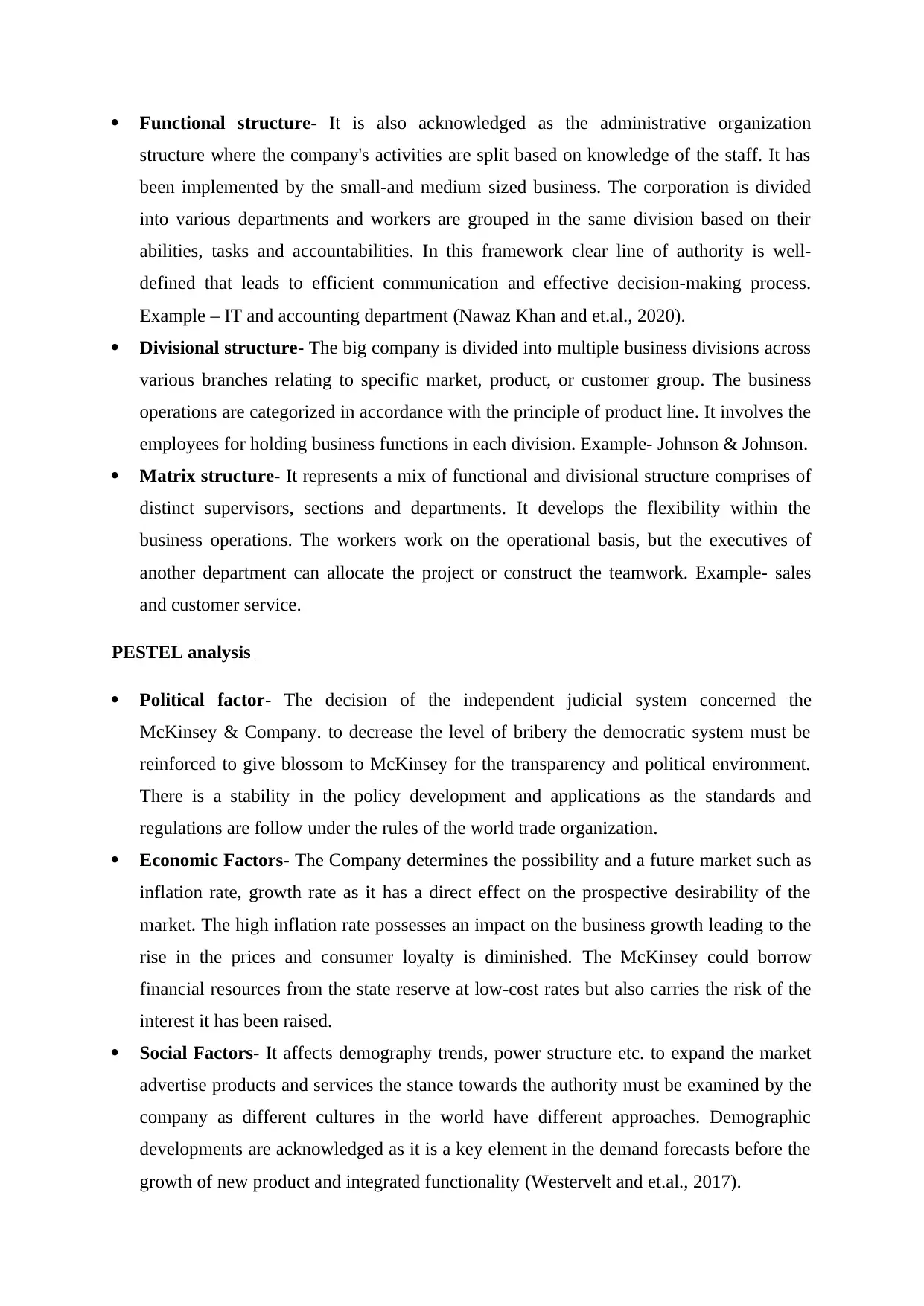
Functional structure- It is also acknowledged as the administrative organization
structure where the company's activities are split based on knowledge of the staff. It has
been implemented by the small-and medium sized business. The corporation is divided
into various departments and workers are grouped in the same division based on their
abilities, tasks and accountabilities. In this framework clear line of authority is well-
defined that leads to efficient communication and effective decision-making process.
Example – IT and accounting department (Nawaz Khan and et.al., 2020).
Divisional structure- The big company is divided into multiple business divisions across
various branches relating to specific market, product, or customer group. The business
operations are categorized in accordance with the principle of product line. It involves the
employees for holding business functions in each division. Example- Johnson & Johnson.
Matrix structure- It represents a mix of functional and divisional structure comprises of
distinct supervisors, sections and departments. It develops the flexibility within the
business operations. The workers work on the operational basis, but the executives of
another department can allocate the project or construct the teamwork. Example- sales
and customer service.
PESTEL analysis
Political factor- The decision of the independent judicial system concerned the
McKinsey & Company. to decrease the level of bribery the democratic system must be
reinforced to give blossom to McKinsey for the transparency and political environment.
There is a stability in the policy development and applications as the standards and
regulations are follow under the rules of the world trade organization.
Economic Factors- The Company determines the possibility and a future market such as
inflation rate, growth rate as it has a direct effect on the prospective desirability of the
market. The high inflation rate possesses an impact on the business growth leading to the
rise in the prices and consumer loyalty is diminished. The McKinsey could borrow
financial resources from the state reserve at low-cost rates but also carries the risk of the
interest it has been raised.
Social Factors- It affects demography trends, power structure etc. to expand the market
advertise products and services the stance towards the authority must be examined by the
company as different cultures in the world have different approaches. Demographic
developments are acknowledged as it is a key element in the demand forecasts before the
growth of new product and integrated functionality (Westervelt and et.al., 2017).
structure where the company's activities are split based on knowledge of the staff. It has
been implemented by the small-and medium sized business. The corporation is divided
into various departments and workers are grouped in the same division based on their
abilities, tasks and accountabilities. In this framework clear line of authority is well-
defined that leads to efficient communication and effective decision-making process.
Example – IT and accounting department (Nawaz Khan and et.al., 2020).
Divisional structure- The big company is divided into multiple business divisions across
various branches relating to specific market, product, or customer group. The business
operations are categorized in accordance with the principle of product line. It involves the
employees for holding business functions in each division. Example- Johnson & Johnson.
Matrix structure- It represents a mix of functional and divisional structure comprises of
distinct supervisors, sections and departments. It develops the flexibility within the
business operations. The workers work on the operational basis, but the executives of
another department can allocate the project or construct the teamwork. Example- sales
and customer service.
PESTEL analysis
Political factor- The decision of the independent judicial system concerned the
McKinsey & Company. to decrease the level of bribery the democratic system must be
reinforced to give blossom to McKinsey for the transparency and political environment.
There is a stability in the policy development and applications as the standards and
regulations are follow under the rules of the world trade organization.
Economic Factors- The Company determines the possibility and a future market such as
inflation rate, growth rate as it has a direct effect on the prospective desirability of the
market. The high inflation rate possesses an impact on the business growth leading to the
rise in the prices and consumer loyalty is diminished. The McKinsey could borrow
financial resources from the state reserve at low-cost rates but also carries the risk of the
interest it has been raised.
Social Factors- It affects demography trends, power structure etc. to expand the market
advertise products and services the stance towards the authority must be examined by the
company as different cultures in the world have different approaches. Demographic
developments are acknowledged as it is a key element in the demand forecasts before the
growth of new product and integrated functionality (Westervelt and et.al., 2017).
Paraphrase This Document
Need a fresh take? Get an instant paraphrase of this document with our AI Paraphraser
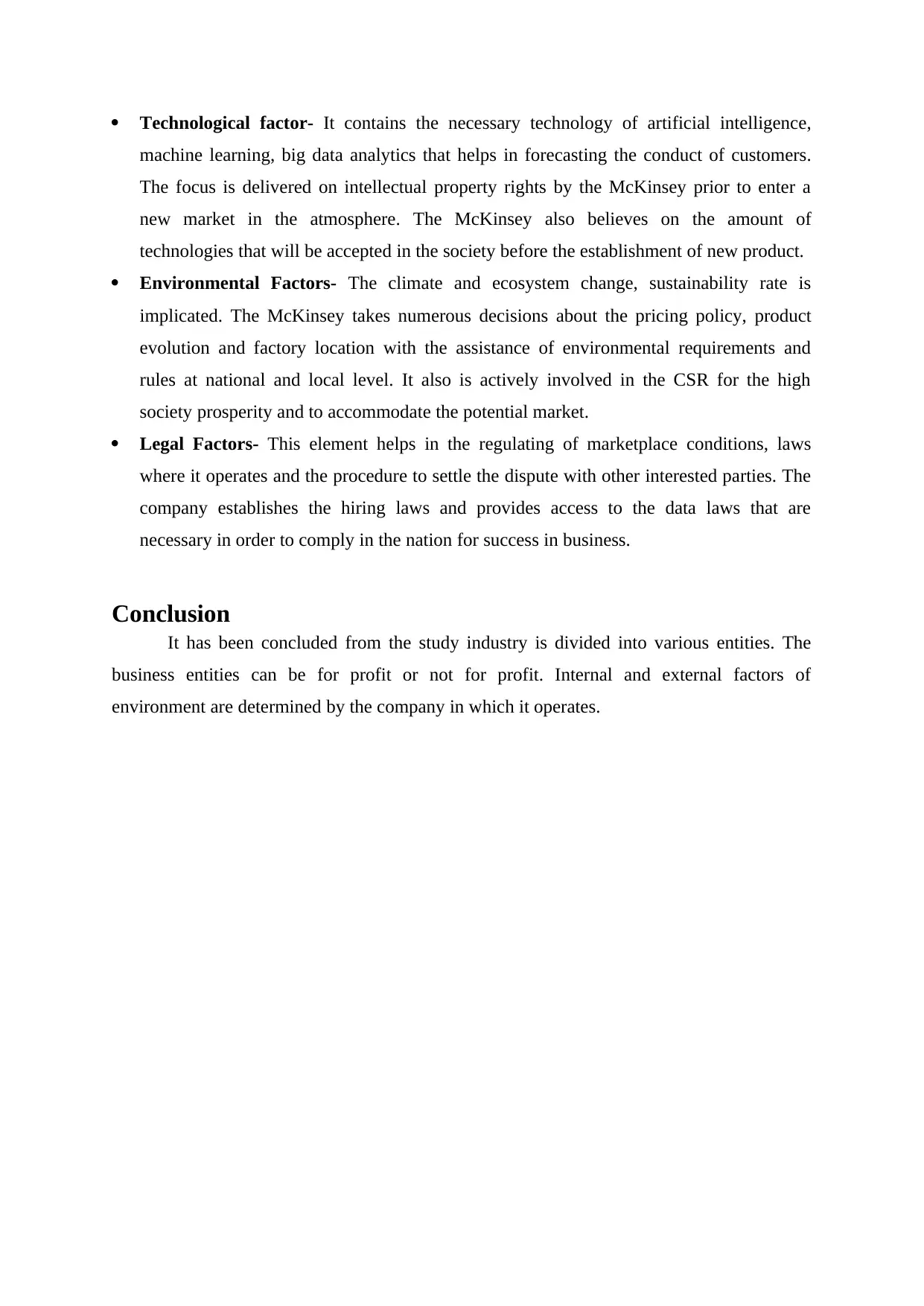
Technological factor- It contains the necessary technology of artificial intelligence,
machine learning, big data analytics that helps in forecasting the conduct of customers.
The focus is delivered on intellectual property rights by the McKinsey prior to enter a
new market in the atmosphere. The McKinsey also believes on the amount of
technologies that will be accepted in the society before the establishment of new product.
Environmental Factors- The climate and ecosystem change, sustainability rate is
implicated. The McKinsey takes numerous decisions about the pricing policy, product
evolution and factory location with the assistance of environmental requirements and
rules at national and local level. It also is actively involved in the CSR for the high
society prosperity and to accommodate the potential market.
Legal Factors- This element helps in the regulating of marketplace conditions, laws
where it operates and the procedure to settle the dispute with other interested parties. The
company establishes the hiring laws and provides access to the data laws that are
necessary in order to comply in the nation for success in business.
Conclusion
It has been concluded from the study industry is divided into various entities. The
business entities can be for profit or not for profit. Internal and external factors of
environment are determined by the company in which it operates.
machine learning, big data analytics that helps in forecasting the conduct of customers.
The focus is delivered on intellectual property rights by the McKinsey prior to enter a
new market in the atmosphere. The McKinsey also believes on the amount of
technologies that will be accepted in the society before the establishment of new product.
Environmental Factors- The climate and ecosystem change, sustainability rate is
implicated. The McKinsey takes numerous decisions about the pricing policy, product
evolution and factory location with the assistance of environmental requirements and
rules at national and local level. It also is actively involved in the CSR for the high
society prosperity and to accommodate the potential market.
Legal Factors- This element helps in the regulating of marketplace conditions, laws
where it operates and the procedure to settle the dispute with other interested parties. The
company establishes the hiring laws and provides access to the data laws that are
necessary in order to comply in the nation for success in business.
Conclusion
It has been concluded from the study industry is divided into various entities. The
business entities can be for profit or not for profit. Internal and external factors of
environment are determined by the company in which it operates.
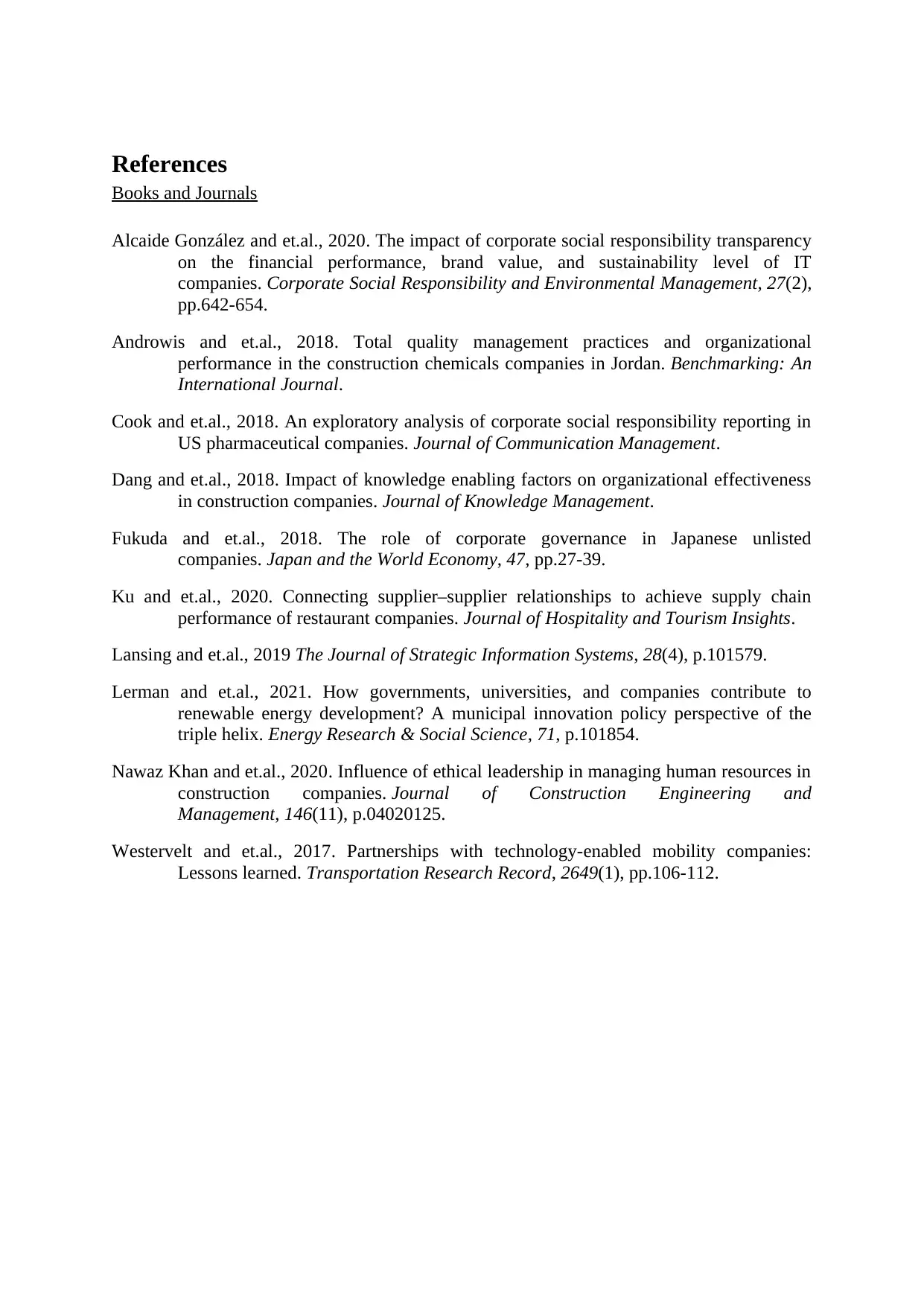
References
Books and Journals
Alcaide González and et.al., 2020. The impact of corporate social responsibility transparency
on the financial performance, brand value, and sustainability level of IT
companies. Corporate Social Responsibility and Environmental Management, 27(2),
pp.642-654.
Androwis and et.al., 2018. Total quality management practices and organizational
performance in the construction chemicals companies in Jordan. Benchmarking: An
International Journal.
Cook and et.al., 2018. An exploratory analysis of corporate social responsibility reporting in
US pharmaceutical companies. Journal of Communication Management.
Dang and et.al., 2018. Impact of knowledge enabling factors on organizational effectiveness
in construction companies. Journal of Knowledge Management.
Fukuda and et.al., 2018. The role of corporate governance in Japanese unlisted
companies. Japan and the World Economy, 47, pp.27-39.
Ku and et.al., 2020. Connecting supplier–supplier relationships to achieve supply chain
performance of restaurant companies. Journal of Hospitality and Tourism Insights.
Lansing and et.al., 2019 The Journal of Strategic Information Systems, 28(4), p.101579.
Lerman and et.al., 2021. How governments, universities, and companies contribute to
renewable energy development? A municipal innovation policy perspective of the
triple helix. Energy Research & Social Science, 71, p.101854.
Nawaz Khan and et.al., 2020. Influence of ethical leadership in managing human resources in
construction companies. Journal of Construction Engineering and
Management, 146(11), p.04020125.
Westervelt and et.al., 2017. Partnerships with technology-enabled mobility companies:
Lessons learned. Transportation Research Record, 2649(1), pp.106-112.
Books and Journals
Alcaide González and et.al., 2020. The impact of corporate social responsibility transparency
on the financial performance, brand value, and sustainability level of IT
companies. Corporate Social Responsibility and Environmental Management, 27(2),
pp.642-654.
Androwis and et.al., 2018. Total quality management practices and organizational
performance in the construction chemicals companies in Jordan. Benchmarking: An
International Journal.
Cook and et.al., 2018. An exploratory analysis of corporate social responsibility reporting in
US pharmaceutical companies. Journal of Communication Management.
Dang and et.al., 2018. Impact of knowledge enabling factors on organizational effectiveness
in construction companies. Journal of Knowledge Management.
Fukuda and et.al., 2018. The role of corporate governance in Japanese unlisted
companies. Japan and the World Economy, 47, pp.27-39.
Ku and et.al., 2020. Connecting supplier–supplier relationships to achieve supply chain
performance of restaurant companies. Journal of Hospitality and Tourism Insights.
Lansing and et.al., 2019 The Journal of Strategic Information Systems, 28(4), p.101579.
Lerman and et.al., 2021. How governments, universities, and companies contribute to
renewable energy development? A municipal innovation policy perspective of the
triple helix. Energy Research & Social Science, 71, p.101854.
Nawaz Khan and et.al., 2020. Influence of ethical leadership in managing human resources in
construction companies. Journal of Construction Engineering and
Management, 146(11), p.04020125.
Westervelt and et.al., 2017. Partnerships with technology-enabled mobility companies:
Lessons learned. Transportation Research Record, 2649(1), pp.106-112.
⊘ This is a preview!⊘
Do you want full access?
Subscribe today to unlock all pages.

Trusted by 1+ million students worldwide

1 out of 10
Related Documents
Your All-in-One AI-Powered Toolkit for Academic Success.
+13062052269
info@desklib.com
Available 24*7 on WhatsApp / Email
![[object Object]](/_next/static/media/star-bottom.7253800d.svg)
Unlock your academic potential
Copyright © 2020–2025 A2Z Services. All Rights Reserved. Developed and managed by ZUCOL.





